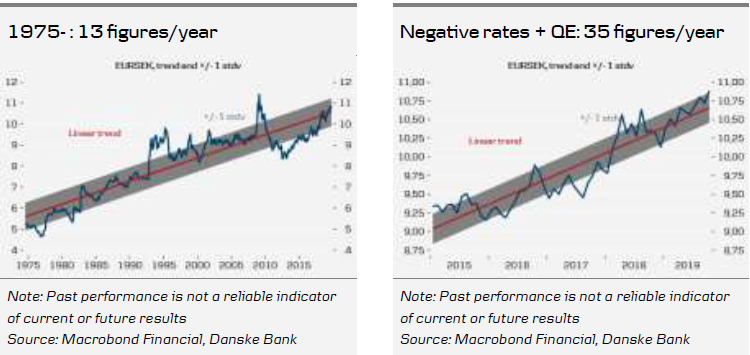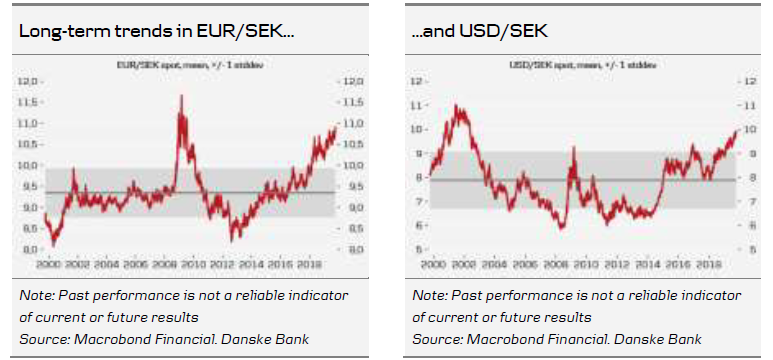SEK: Winter is coming
In Reading the Markets Sweden, 27 September, we pointed out the macro risks and the outlook for EUR/SEK for the month of October, 'a challenging month for the krona'. We proposed (1) that it might prove fruitful to short SEK against EUR, USD, JPY and/or AUD in the short term, (2) that importers and other natural net buyers should act early in the month and (3) that exporters and other natural sellers might as well wait until the end of the month.
The seasonal pattern divulges that October is the worst month of the year for the SEK: the 5Y average is a 1.1% increase in EUR/SEK and the cross has risen every year since 2012, with a minimum of +0.2% and a maximum of +2.7% (see table later in this document). We argue that this seasonal pattern is due mostly to macroeconomics. At the time of writing, EUR/SEK was up 1.2% since the turn of the month (see the chart below).

We previously emphasised that PMI was the first ‘very important’ macro trigger in the month of October, given that we saw scope for a fall below 50. This decline is materialising but we confess to being surprised by the sheer force of the movement in FX: +7 figures over the day and EUR/SEK printing above 10.80. Since then, we have also seen a high of 10.93. Yesterday’s CPIF at 1.3%, in line with the RB’s estimate but 0.1pp above consensus, yielded a somewhat bigger downside movement in EUR/SEK than the historical pattern would suggest.
The next ‘very important’ macro triggers are labour market statistics (due 17 October) and the Riksbank (RB) rate decision (due 24 October). As far as the labour market is concerned, we see scope for a positive rebound, which would mitigate the worst fears and provide further relief for the SEK. Nevertheless, we remain firm on our view that the downturn is (and will be) sharper than proposed by the RB. The labour market is deteriorating, there is a marked cyclical slowdown (which NIER now also forecasts), inflation is muted and expectations are falling, with external growth conditions worsening, as illustrated by the IMF’s warnings of sizeable cuts in the global growth prospects and international central banks cutting rates. In our view, it would be very odd for the RB to hike rates in the aforementioned setting. Once again, we refer to NIER, which forecast unchanged rates until end-2022.
There are compelling arguments for the RB to remove its turn-of-the-year hike as early as the October meeting, although the latest inflation outcome spot on forecast might lend the RB some support, although at this point it does not signal an upcoming cut (which is our base case: -0.25p cut in February 2020). How would this effect the SEK? The SEK has weakened quite substantially since the latest RB meeting: KIX is 3% above its forecast.
Pricing in RIBA contracts has fluctuated wildly and is currently indicating +3bp at the end of this year. Should the RB turn dovish, we have a hard time believing that we will see rates increasing and the SEK rising. However, one might argue that EUR/SEK has to some extent already considered this and if so, this might somewhat limit the movement in the cross.

However, we can easily imagine a more malign scenario, where the SEK crosses take out new highs, volatility surges and the SEK depreciation accelerates. We cannot rule this out should all hope of non-negative rates fade and if talks of a global recession gain traction, with everything this would entail for Swedish exporters, investments and employment.
Should the SEK lose it completely and volatility surge, we have a hard time envisaging any interest to be contrarian – even if one considers the SEK substantially undervalued. In a scenario such as that outlined above, liquidity issues could also come into play and on their own enhance the upward movements in EUR/SEK and USD/SEK.
Is the RB worried by the developments in the SEK? The answer is yes and no: no because it (at least theoretically) spurs inflation and yes because it would not want to contribute to a veritable collapse in the SEK. As previously stated, KIX is 3% above the forecast and we cannot entirely dismiss the idea that the RB could point to this and the latest inflation print in order to stick to its hiking ambitions. In the minutes from July, Martin Flodén clearly expressed his concerns about the SEK depreciation. He argued that further depreciation would neither boost growth nor be a desirable means of bolstering inflation. We agree with Flodén on both these claims. However, in our opinion, it is not enough that Flodén, who for the record has consistently argued against the RB’s plans for FX intervention, is standing up for the SEK. He needs to have more board members onboard. We find this implausible, as the RB would then be at risk of shooting itself in the foot. However, were it to do this, it would be a major game changer for the SEK.
However, the RB has an inflation target and our belief is that this will continue to dictate monetary policy for the time being. As long as the wanted inflationary pressure from the labour market and rising wages are missing, pressure will remain for the SEK to compensate via import prices in order to get inflation back to target. The rationality in this could be called into question, especially as pass-through is seemingly rather muted.

However, this is the reality; inflation is not self-sustaining. With this in mind, the base scenario for the SEK ought to encompass continual depreciation, as it always has been, regardless of the FX regime. Since the RB introduced negative rates, EUR/SEK has on average risen almost 10 figures each quarter (right-hand chart below).
We have been bearish on the SEK for quite some time. This has been a strategically sound stance as it turns out. Nevertheless, the weaker the SEK gets, the more important it is for us to scrutinise our arguments. As far as macro and the RB are concerned, i.e. the cyclical factors, we see no sufficiently convincing arguments for any imminent turnaround. In terms of long-term fundamentals and valuation, we would say that the SEK has probably weakened more than is justified, e.g. both PPP and the in-house MEVA model indicate a fundamental equilibrium in EUR/SEK close to 10.00. This does not necessarily mean that the trend depreciation of the SEK has reached the end of the road. FX trends do not die of old age. It needs a trigger.

One such potential trigger could be if the Swedish government decides to pursue expansionary (truly expansionary) fiscal policy, boosting growth and inflation prospects and easing some of the RB’s burden. Aaccording to textbook economics, such a policy mix should support the SEK. In our view, this will surely be discussed. For the time being, however, the interest from politicians is rather cool. We believe this is sure to change should the Swedish economy continued to deteriorate. At the same time, said deterioration is in itself SEK negative. Another potential trigger could be the Fed cutting rates to zero and thereby killing the carry argument for long USD/short SEK. This could also spillover into lower EUR/SEK given that the SEK has been the main loser in the carry game. We do not believe this to be probable but believe it is far from unlikely and hence worth watching. A third possible trigger would be some kind of intervention against an SEK weakening going overboard. Honestly though, we have a hard time seeing this happening. In this context, we would like to flag the review of the monetary policy framework and the RB act that is currently ongoing and due for release on 30 November at the latest. It is a possibility that the review will end up with the recommendation that the RB should not be allowed to intervene in FX markets, given that FX policy belongs to the government. However, once again, we have a hard time seeing anything that would hamper monetary policy: we do remember how the government pummelled the SNDO when it asked for an increased FX mandate, as this was not aligned with the RB’s wishes.
Overall, we believe it is premature to abandon our bearish view on the SEK. We are well aware that SEK bashing is somewhat consensus now – and this warrants caution. Nevertheless, given that recent weeks’ movements have exceeded our bullish EUR/SEK forecast and given that we continue to see headwinds for the SEK in our baseline macro scenario where the growth outlook deteriorates domestically and abroad and where the RB cuts rates, we see scope for rolling and recalibrating our forecast: we raise our 1M forecast to 10.90 (previously 10.70), 3M (NYSE:MMM) to 11.00 (was 10.80), 6M to 11.20 (was 10.90) and 12M to 11.20 (was 11.00). Our 6M estimate builds on our call for a RB cut in Q1 next year. In our view, USD/SEK could very well breach 10.00 before year-end.

